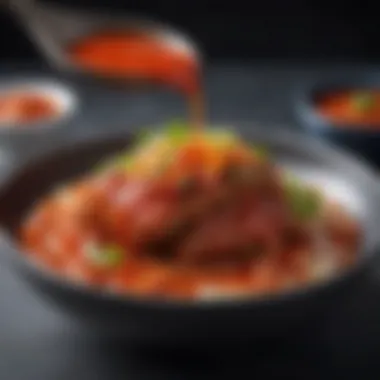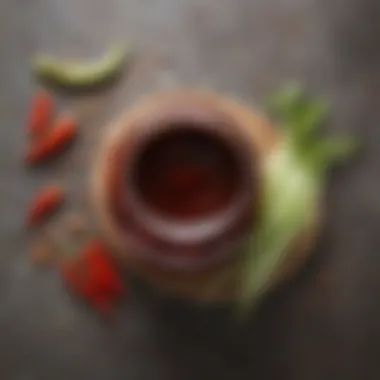Exploring the Depths of Spicy Gochujang Sauce


Intro
Gochujang sauce is a staple in Korean cuisine, celebrated for its unique balance of heat, sweetness, and umami. This fermented chili paste, rich in flavor and texture, has gained international attention, appealing to chefs and home cooks alike. Understanding gochujang encompasses not only its culinary applications but also its historical and cultural significance.
Within this article, we will dissect the essence of gochujang. From its origins tracing back centuries in Korea to how it enhances diverse dishes, readers will gain insights relevant to both cooking enthusiasts and those merely curious. As we navigate through its flavor profile, preparation techniques, and myriad uses, we aim to share practical advice for crafting authentic gochujang sauce at home. Furthermore, incorporating gochujang into everyday meals can transform the dining experience, promising richness without extensive complexity.
This article aims to serve as a thoughtful resource—a guide for those looking to explore the multifaceted nature of spicy gochujang sauce, inviting flavors into their daily cuisine.
Prelude to Gochujang Sauce
Gochujang sauce stands as a cornerstone of Korean cuisine, renowned for its rich flavor and versatility. Understanding this sauce is vital for anyone keen on delving deeper into Korean dishes or simply looking to enhance their culinary repertoire. Gochujang combines unique taste profiles with cultural significance, making it essential for both cooking enthusiasts and food lovers.
Defining Gochujang
Gochujang is a fermented Korean chili paste, striking a balance of sweet, savory, and spicy flavors. This sauce is made primarily from red chili powder, glutinous rice, fermented soybean powder, salt, and sugar. The fermentation process contributes complexity and depth, with each ingredient playing a crucial role in the final flavor. The color is typically a deep crimson, indicating its rich chili content.
The texture of gochujang is thick and sticky, allowing it to adhere well to ingredients, making it perfect for marinades and sauces. To truly appreciate this condiment, one must recognize that it is not merely about heat. Its nuanced sweetness and umami elements elevate simple dishes into culinary experiences.
The Cultural Significance of Gochujang
Gochujang is more than just a sauce; it is a cultural emblem in Korea. Used for centuries, it reflects the Korean art of fermentation and natural preservation. Traditionally, gochujang was produced at home, often passed down through generations, a process that signified family heritage and pride. It plays a crucial role in various Korean festivals and gatherings.
In current culinary landscapes, gochujang's influence has broadened. Its presence can be felt in fusion cuisines across the globe, proving its adaptability. It has become essential in popular dishes like bibimbap and tteokbokki, thereby showcasing its integral role in Korean culinary tradition.
"Gochujang not only enhances food but also serves as a bridge between cultures, connecting Korean heritage with global cuisine."
In summary, understanding gochujang's definition and cultural importance enlightens one's appreciation of this dynamic ingredient. It incorporates history, tradition, and flavor in a way few other sauces can. Anyone interested in cooking, especially Korean food, will find value in incorporating gochujang into their kitchen.
Ingredients of Gochujang Sauce
Understanding the ingredients of gochujang sauce is crucial in appreciating its complexity and depth. Each component contributes to the overall flavor and character of the sauce, which makes it a staple in Korean cuisine. Not only does each ingredient play a role in taste, but they also enhance the texture and nutritional profile. Knowing the specifics about each component can help cooks create better versions of this versatile sauce.
Key Components
The five main ingredients that define gochujang sauce are red chili powder, rice or glutinous rice, fermented soybean powder, salt, and sugar. Each element has its unique features, and understanding them adds depth to the cooking experience.
Red chili powder
Red chili powder is the primary heat source in gochujang. It brings not just spiciness but also a distinct color and a touch of sweetness. Gochugaru, the Korean red chili powder, is a popular choice due to its rich taste and vibrant hue. This specific chili powder is coarsely ground, which gives it a unique texture and allows for a more complex flavor profile compared to finely ground chilies. One downside is that its heat levels can vary, which may affect the final spice level of the sauce. Choosing a steady brand can help mitigate this.
Rice or glutinous rice
Rice or glutinous rice acts as the base for gochujang. It provides essential carbohydrates and a slight sweetness that balances the heat from the red chili powder. The rice is fermented, which contributes to the sauce's overall flavor and texture. Gochujang will not be the same without this ingredient because it ensures the sauce maintains a thick consistency. Glutinous rice is often preferred for its sticky nature, although regular rice can be used. Using plain rice might make the sauce less smooth, possibly leading to a less enjoyable eating experience.
Fermented soybean powder
Fermented soybean powder adds a robust umami flavor to gochujang. It is made from soybeans that have undergone a fermentation process, which significantly intensifies the taste. This ingredient is not only important for flavor but it also packs beneficial probiotics. However, the fermentation can be a tricky process, and using fresh powder is essential. Outdated soybean powder can lead to undesirable flavors. Its inclusion is critical in achieving the authentic taste of gochujang.
Salt
Salt is not merely a flavor enhancer; it plays a vital role in the fermentation process. It helps draw out moisture from the ingredients and regulates the fermentation. In gochujang, salt ensures that the sauce doesn’t spoil and allows the flavors to meld together. Too much salt, however, can mask other flavors, making the sauce overly salty. It is usually best to add salt gradually during preparation, adjusting it to taste rather than relying on a fixed measurement.
Sugar


Sugar provides the sweetness that balances out the heat from the chili powder. It rounds out the flavor profile, contributing to the overall harmony of the sauce. While granulated sugar is typically used, some recipes may substitute with brown sugar for added depth. The caveat about sugar, however, is that too much can overshadow the spicy and savory notes of the sauce. Using sugar judiciously is crucial to maintain the essence of gochujang.
Understanding Fermentation
Fermentation is a cornerstone of many Asian cuisines, including Korean. In the case of gochujang, fermentation is what transforms ordinary ingredients into a complex, layered flavor. During fermentation, beneficial bacteria break down sugars and starches into their simpler forms. This process not only enhances taste but also improves digestibility and adds nutritional value.
The length of fermentation can vary and often depends on environmental conditions like temperature and humidity. A traditional homemade gochujang may take several months to fully develop its flavor. Understanding fermentation can significantly improve the quality of home-cooked dishes. Thus, it is important to be patient, as the rewards of fermentation yield a richer and more satisfying sauce.
"Fermented foods are part of a healthy diet, contributing positively to gut health."
Flavor Profile of Gochujang Sauce
Understanding the flavor profile of gochujang sauce is crucial for anyone looking to incorporate this ingredient into their cooking. Gochujang is not merely a spicy condiment; its complexity lies in the perfect balance of three primary taste elements: sweetness, heat, and umami. Exploring these aspects can elevate a dish significantly, making it not only flavorful but also memorable.
Sweetness
The sweetness of gochujang is a defining characteristic that balances its fiery heat. This sweetness primarily comes from sugar, which is added during the fermentation process. Some recipes may also include honey or syrup to enhance this essence. This sweet component not just tempers the heat but also enriches the overall flavor, allowing it to blend seamlessly into various dishes.
The sweetness makes gochujang a versatile ingredient. For instance, it works well in marinades, combining pleasantly with proteins like chicken or pork, giving a sweet and spicy crust when cooked. In dressings or dipping sauces, it adds depth that can elevate the simplest of meals. In many Asian dishes, a touch of sweetness encourages harmony among contrasting flavors.
Heat Level
The heat level of gochujang often surprises those unfamiliar with this sauce. It features a moderate to high level of heat, driven by the red chili powder used in its preparation. This heat is different from the sharp bite often found in hot sauces. Instead, it feels more rounded and lingering. The heat can adjust according to personal preference, as one can control the amount used in recipes.
Understanding the heat of gochujang is essential. It can bring a kick to any element of cooking, whether it is used in soups or stir-fries. For individuals who enjoy spicy food, gochujang allows for endless possibilities in creating flavorful dishes. However, using it in moderation is key to finding the right balance. Too much can overshadow other flavors.
Umami Taste
Lastly, the umami taste is perhaps the most intriguing aspect of gochujang. This savory flavor can be attributed to the fermented soybean powder found in the sauce. The fermentation process adds complexity and richness, contributing a deep, satisfying quality to dishes.
Incorporating the umami element of gochujang into meals can result in more well-rounded flavor profiles. When paired with ingredients like miso or soy sauce, gochujang becomes a powerful tool in creating layers of taste. The presence of this umami flavor makes it ideal in recipes such as stews or soups, offering a satisfying experience that keeps diners wanting more.
In summary, the flavor profile of gochujang sauce is a harmonious blend of sweetness, heat, and umami. This balance makes it a unique ingredient in various culinary applications, inviting experimentation and creativity in the kitchen.
Homemade Gochujang Sauce Recipe
Creating homemade gochujang sauce is an essential part of fully appreciating its complex flavor. Making it yourself provides control over the level of heat, sweetness, and overall taste, allowing you to craft a sauce that aligns perfectly with your cooking style. Furthermore, homemade gochujang often avoids preservatives and unnecessary additives found in store-bought versions, enhancing both the taste and health benefits.
Essential Equipment
Before you begin the process of making gochujang, it is crucial to gather the right equipment. You will need:
- Mixing Bowl: A large bowl is needed to combine the ingredients effectively.
- Whisk or Spoon: To mix the components together until you reach a smooth consistency.
- Measuring Cups and Spoons: Accurate measurements ensure that your sauce maintains the desired flavor balance.
- Storage Container: A clean, airtight container to store your gochujang sauce once prepared. Glass jars are preferred for their durability and non-reactive properties.
Having these pieces of equipment ready helps streamline the preparation process.
Step-by-Step Preparation
- Ingredients Gathering: Start by measuring out the essential ingredients, which include red chili powder, rice or glutinous rice, fermented soybean powder, salt, and sugar. Each of these contributes vital flavor and texture to the sauce.
- Prepare the Base: If you are using rice, cook the rice first and let it cool slightly. It should ideally be sticky, helping to bind the sauce together.
- Mix Ingredients: In a mixing bowl, combine the red chili powder, rice, fermented soybean powder, salt, and sugar. Use a whisk or your spoon to thoroughly blend the dry components.
- Incorporate Water: Gradually add a small amount of water to the mixture. This step requires careful attention as too much water can lead to an overly runny sauce. Aim for a paste-like consistency.
- Flavor Adjustment: Taste the mixture and adjust the seasoning. If you desire more heat, incorporate additional chili powder. For more sweetness, increase the sugar content.
- Final Mixing: Make sure all ingredients are well combined, creating a uniform color and texture. Once mixed, transfer the gochujang to the airtight storage container.
This process can take around 15 to 20 minutes, resulting in a rich, flavorful gochujang sauce tailored to your personal palate.
Storage Tips


To maintain the quality of your homemade gochujang, consider these storage tips:
- Refrigeration: Store the sauce in the refrigerator. It can last for several weeks, but its flavor may deepen over time due to fermentation.
- Labeling: Make use of labels with the date of preparation. This helps track its shelf life.
- Avoid Contamination: Always use clean utensils when taking sauce from the container to prevent bacteria growth.
- Freezing Option: If you have made a large batch, consider freezing portions. Use ice cube trays for easy measuring when needed later.
Following these guidelines ensures you enjoy your gochujang sauce while preserving its wonderful flavors.
Culinary Applications of Gochujang Sauce
Gochujang sauce is a versatile ingredient that enhances a variety of dishes. Its unique blend of sweetness, heat, and umami makes it suitable for many culinary applications. Understanding how to use this sauce effectively can elevate ordinary meals into something truly special, making it a valuable addition to any kitchen. Experimentation with gochujang can lead to exciting flavors that are both satisfying and memorable.
Marinades
Gochujang is an excellent base for marinades. Its thick consistency allows it to cling well to meats and vegetables, infusing them with flavor. Combining gochujang with soy sauce, sesame oil, and garlic creates a marinade that tenderizes proteins while adding depth. When marinating chicken, beef, or tofu, it is advisable to let them sit for several hours or overnight for optimal flavor absorption. The result is an irresistible layer of taste that permeates each bite.
Dipping Sauces
Another popular use for gochujang is as a dipping sauce. Mixing it with ingredients like vinegar, honey, and sesame seeds provides a delightful contrast of flavors. This sauce complements a wide range of appetizers, from spring rolls to vegetable platters. The blend of sweet, spicy, and tangy notes in gochujang-based dipping sauces makes it a favorite for gatherings and parties. It allows guests to experience a taste of Korean cuisine in an easy-to-serve format.
In Soups and Stews
Incorporating gochujang into soups and stews is a fantastic way to enhance the overall flavor profile. Adding a spoonful or two to traditional recipes like Korean jjigae not only increases the spice level but also introduces a deep, rich taste. The fermentation process of gochujang contributes to a rounded umami flavor that enriches the broth. For those looking to experiment, try adding it to ramen or chili for a creative twist.
In Stir-Fry Dishes
Gochujang shines brightly in stir-fry dishes. Its robust flavor marries well with stir-fried vegetables and proteins, creating a harmonious dish full of color and taste. Mixing it with soy sauce and a little oil helps to create a tantalizing stir-fry sauce. This versatile ingredient can be used with a range of vegetables, meats, and noodles, making it adaptable to various dietary preferences. Whether you're cooking a quick weeknight dinner or an elaborate meal, gochujang adds a distinctive element that elevates the dish.
Incorporating gochujang into your cooking opens a world of bold flavors and culinary creativity.
Enhancing Dishes with Gochujang Sauce
Gochujang sauce brings a depth of flavor that can elevate many dishes. Its unique blend of heat, sweetness, and umami makes it a versatile ingredient in a variety of culinary contexts. Understanding how to enhance dishes with this sauce can lead to more vibrant meals, appealing not just to the palate but also to the overall dining experience.
Balancing Spice with Sweetness
Gochujang is known for its spicy profile, but it also possesses a distinctive sweetness. Balancing these two aspects is essential when using gochujang in your recipes. Sweet components can temper the heat and create a harmonious flavor. Ingredients such as honey, brown sugar, or agave can be added to enhance the sweetness. Consider dishes like glazes for meats or marinades where a sweet contrast can work well with the spice of gochujang.
When balancing flavors, it’s crucial to taste as you go. Adding small amounts of sweetener incrementally helps you achieve the desired balance. This approach allows you to control the spice level and ensure that the dish satisfies the preferences of your guests or family.
Pairing with Other Ingredients
The versatility of gochujang means it can pair seamlessly with a range of ingredients. Combining it with ingredients like garlic, ginger, or sesame can enhance the overall profile of your dishes. These components help to deepen the flavor while adding layers of complexity.
- Garlic and Onion: These ingredients work well to provide a savory backbone.
- Sesame Oil and Seeds: They introduce nuttiness, complementing the spiciness of gochujang.
- Vinegars: A splash of rice vinegar or apple cider vinegar can brighten a dish, balancing the richness.
Experimenting with different combinations helps uncover flavors that elevate your meals, making them more enjoyable.
Utilizing in Dressings
Gochujang also shines in the realm of dressings. Its creamy texture can be harnessed to create rich and flavorful applications. Consider using gochujang in salad dressings to provide a kick that lightens up heavier ingredients. A simple dressing can be made by mixing gochujang with soy sauce, sesame oil, and lime juice. This combination not only provides heat but also a well-rounded flavor that can brighten a fresh salad or grains.
Incorporating gochujang into dressings encourages creativity. You can drizzle it over roasted vegetables, grilled meats, or even use it as a finishing sauce for sushi bowls.
A sprinkle of gochujang in a dressing can transform ordinary salads into gourmet experiences.


By understanding how to effectively enhance dishes with gochujang sauce, you can create meals that are exciting and flavorful. The integration of sweet, bitter, and spicy elements facilitates a deeper culinary exploration, opening doors to new tastes.
Health Considerations
Health considerations play a significant role in understanding any culinary component, and gochujang is no exception. While this spicy Korean condiment adds depth and flavor to dishes, it also comes with nutritional elements that can impact your health, especially when consumed regularly. Recognizing both its benefits and potential drawbacks allows individuals to use gochujang more wisely.
Nutritional Value
Gochujang offers a unique combination of nutrients. It primarily contains the following:
- Capsaicin: The compound responsible for the heat in chili peppers. It is known to have anti-inflammatory properties.
- Carbohydrates: A source of energy, mainly from sugar and starch present in glutinous rice.
- Proteins: Some proteins come from fermented soybeans, contributing to its overall nutritional value.
- Vitamins: Contains some vitamins, particularly B vitamins, which are crucial for various metabolic processes.
A typical serving size, about one tablespoon, contains approximately 30 calories. Notably, gochujang is low in fat. This makes it a flavorful option for those looking to enhance meals without adding excessive calories. However, it is essential to be mindful of sodium content that can vary between brands.
Moderation in Consumption
The principle of moderation should guide the use of gochujang. While it offers several health benefits, overconsumption may lead to negative effects. The high sodium content can contribute to elevated blood pressure levels if consumed excessively. For individuals with certain health conditions, like hypertension or gastroesophageal reflux disease, moderation becomes even more critical.
It's advisable to incorporate gochujang in a balanced diet. Pair it with fresh vegetables, lean meats, or whole grains to create healthier meals. When using gochujang as a marinade or dressing, controlling the amount used is crucial. Opt for homemade versions if possible to manage ingredients and avoid preservatives.
"Using gochujang wisely not only enhances the flavor but also supports a sensible dietary approach."
Health connoisseurs should enjoy gochujang for its vibrant flavor while balancing it with other nutritional choices. The key lies in understanding your body's unique response and adjusting intake accordingly. As with many foods, knowing when to indulge and when to restrain can ultimately lead to a more enjoyable and healthful culinary experience.
The End
The conclusion serves as a vital component in reinforcing the comprehensive insights discovered throughout the article about gochujang sauce. This section encapsulates the essence of the previous discussions, ensuring that the significant role of gochujang in culinary applications is thoroughly conveyed.
Recap of Gochujang's Role
Gochujang plays a fundamental role in Korean cuisine and increasingly influences various global culinary trends. It is not merely a condiment; it embodies history, culture, and an extraordinary depth of flavor. The sauce, with its unique combination of sweetness, umami, and spice, enriches myriad dishes ranging from marinades to soups. Its versatility makes it a staple for both home cooks and experienced chefs. Reintroducing it into personal kitchens opens a gateway to explore various flavors and encourages experimentation with different recipes. Its growing popularity suggests that many find value in its ability to transform simple meals into extraordinary culinary experiences.
Encouragement to Experiment
Exploration in the kitchen should be viewed as an opportunity, not a limitation. Gochujang can be incorporated in various unexpected ways. For those hesitant to use it, starting with small amounts allows for gradual acclimatization to its potent flavor profile. Mixing gochujang into dressings, sauces, or marinades can enhance the depth without overwhelming the dish. Furthermore, employing it in fusion cuisine can yield exciting results.
Being creative with gochujang encourages cooks, regardless of skill level, to develop personal recipes. The possibilities are extensive; adding it to a traditional pasta dish or using it in a unique salsa can produce remarkable outcomes. This experimentation not only expands culinary skills but also personalizes meals to individual taste preferences.
Further Resources
In the realm of culinary exploration, having access to relevant resources is crucial for both novice and seasoned cooks alike. Further resources enrich one’s understanding of gochujang, allowing individuals to explore its diverse applications and history with greater depth. This section will provide essential materials to help enhance knowledge and cooking skills related to this unique Korean condiment.
Books on Korean Cuisine
Books dedicated to Korean cuisine serve as a gateway to the rich culinary traditions of the region. They often feature a variety of recipes that incorporate gochujang, from traditional dishes to modern adaptations. To enhance your cooking, consider some of these titles:
- Korean Home Cooking: Authentic Recipes from My Mother's Kitchen by Sohui Kim
- The Food of Korea: A Journey for Food Lovers by Jae Kwang Lee
- Everyday Korean Cooking by Kim Sunée
These books not only offer recipes but also delve into methods, ingredients, and the cultural context behind various dishes. Readers can gain insight into the nuances of flavors and techniques through the lens of culinary artistry.
Online Tutorials
The internet has become a treasure trove of culinary resources, providing countless online tutorials which can complement the information from books. Websites like Reddit and YouTube are filled with cooking enthusiasts sharing their experiences and expertise. Here are some notable platforms to consider:
- Tutorials on YouTube: Channels such as Maangchi and Korean Bapsang deliver engaging cooking videos, often featuring gochujang in their recipes.
- Reddit: Communities such as r/KoreanFood offer discussions, recipe sharing, and real-life tips from fellow food lovers.
- Food blogs: Several bloggers specialize in Korean cooking and provide detailed tutorials, tips, and tricks for using gochujang effectively.
Utilizing these online resources allows home cooks to see ingredients and techniques in action. They can also foster a sense of community as individuals share their culinary journeys, eager to discover new ways to enjoy gochujang in everyday cooking.
Access to diverse resources enables cooks to master the art of incorporating gochujang into various dishes, ultimately enriching their culinary repertoire.







